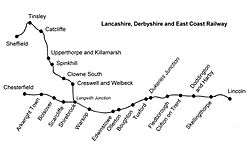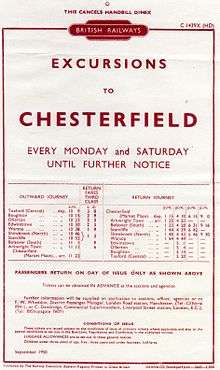Boughton railway station (Nottinghamshire)
Boughton railway station served the village of Boughton in Nottinghamshire, England from 1897 to 1955 when it was closed. It has since been razed to the ground.
| Boughton (Notts) | |
|---|---|
_railway_station.jpg) The site of the former station | |
| Location | |
| Area | Newark and Sherwood, Nottinghamshire |
| Grid reference | SK 688 678 |
| Operations | |
| Original company | LD&ECR |
| Pre-grouping | Great Central Railway |
| Post-grouping | LNER British Railways |
| Platforms | 2 |
| History | |
| 8 March 1897 | Opened |
| 19 September 1955 | Closed[1] |
| Disused railway stations in the United Kingdom | |
| Closed railway stations in Britain A B C D–F G H–J K–L M–O P–R S T–V W–Z | |
| Lancashire, Derbyshire & East Coast Railway | |||||||||||||||||||||||||||||||||||||||||||||||||||||||||||||||||||||||||||||||||||||||||||||||||||||||||||||||||||||||||||||||||||||||||||||||||||||||||||||||||||||||||||||||||||||||||||||||||||||||||||||||||||||||||||||||||||||||||||||||||||||||||||||||||||||||||||||||||||||||||||||||||||||||||||||||||||||||||||||||||||||||||||||||||||||||||||||||||||||||||||||||||||||||||||||||||||||||||||||||||||||||||||||||||||||||||||||||||||||||||||||||||||||||||||||||||||||||||||||||||||||||
|---|---|---|---|---|---|---|---|---|---|---|---|---|---|---|---|---|---|---|---|---|---|---|---|---|---|---|---|---|---|---|---|---|---|---|---|---|---|---|---|---|---|---|---|---|---|---|---|---|---|---|---|---|---|---|---|---|---|---|---|---|---|---|---|---|---|---|---|---|---|---|---|---|---|---|---|---|---|---|---|---|---|---|---|---|---|---|---|---|---|---|---|---|---|---|---|---|---|---|---|---|---|---|---|---|---|---|---|---|---|---|---|---|---|---|---|---|---|---|---|---|---|---|---|---|---|---|---|---|---|---|---|---|---|---|---|---|---|---|---|---|---|---|---|---|---|---|---|---|---|---|---|---|---|---|---|---|---|---|---|---|---|---|---|---|---|---|---|---|---|---|---|---|---|---|---|---|---|---|---|---|---|---|---|---|---|---|---|---|---|---|---|---|---|---|---|---|---|---|---|---|---|---|---|---|---|---|---|---|---|---|---|---|---|---|---|---|---|---|---|---|---|---|---|---|---|---|---|---|---|---|---|---|---|---|---|---|---|---|---|---|---|---|---|---|---|---|---|---|---|---|---|---|---|---|---|---|---|---|---|---|---|---|---|---|---|---|---|---|---|---|---|---|---|---|---|---|---|---|---|---|---|---|---|---|---|---|---|---|---|---|---|---|---|---|---|---|---|---|---|---|---|---|---|---|---|---|---|---|---|---|---|---|---|---|---|---|---|---|---|---|---|---|---|---|---|---|---|---|---|---|---|---|---|---|---|---|---|---|---|---|---|---|---|---|---|---|---|---|---|---|---|---|---|---|---|---|---|---|---|---|---|---|---|---|---|---|---|---|---|---|---|---|---|---|---|---|---|---|---|---|---|---|---|---|---|---|---|---|---|---|---|---|---|---|---|---|---|---|---|---|---|---|---|---|---|---|---|---|---|---|---|---|---|---|---|---|---|---|---|---|---|---|---|---|---|---|---|---|---|---|---|---|---|---|---|---|---|---|---|---|---|---|---|---|---|---|---|---|---|---|---|---|---|---|---|---|---|---|---|---|---|---|---|---|---|---|---|---|---|---|---|---|---|---|---|---|---|---|---|---|---|---|---|---|---|---|---|
| |||||||||||||||||||||||||||||||||||||||||||||||||||||||||||||||||||||||||||||||||||||||||||||||||||||||||||||||||||||||||||||||||||||||||||||||||||||||||||||||||||||||||||||||||||||||||||||||||||||||||||||||||||||||||||||||||||||||||||||||||||||||||||||||||||||||||||||||||||||||||||||||||||||||||||||||||||||||||||||||||||||||||||||||||||||||||||||||||||||||||||||||||||||||||||||||||||||||||||||||||||||||||||||||||||||||||||||||||||||||||||||||||||||||||||||||||||||||||||||||||||||||


Context
The station was opened by the LD&ECR on its main line from Chesterfield Market Place to Lincoln. The LD&ECR was taken over by the GCR in 1907 and subsequently became part of the LNER in 1923 then British Railways on nationalisation in 1948. The platforms were wooden, similar to the high level platforms at Dukeries Junction.[2] The stationmaster's house was characteristic of the line, but the station buildings were not, they appear to have been made of wood,[3][4] but on another page Dow himself says otherwise.[5]
The line crossed a series of ridges between river valleys. From Ollerton it climbed at around 1 in 150 to Boughton after which it descended to Tuxford Central heading towards the River Trent.[6]
Former Services
There never was a Sunday service at Boughton.
In 1922 three trains per day plied between Chesterfield Market Place and Lincoln with a market day extra on Fridays between Langwith Junction and Lincoln. All these trains called at all stations, though on the Friday extra Boughton was a request stop.[7]
From 1951 trains stopped running through to Chesterfield, turning back at Langwith Junction instead. Otherwise the same pattern continued until the last train on 17 September 1955.
Coal
The Wigan Coal and Iron Company intended to open a new colliery at Bevercotes and the LD&ECR obtained powers to build a branch from Boughton sidings. It did not materialise and for many years the branch terminated at a set of buffers in the countryside. The colliery was opened in 1965 and the stub of line finally came into use.[8]
During World War II a connection was made to serve Boughton Ordnance Depot which had a large contingent of American service personnel.
Modern Times
The line through Boughton Station was reopened to non-passenger traffic in August 2009 as the High Marnham Test Track. The line is used by Network Rail to test new engineering trains and on-track plant.
The new test line runs from Thoresby Colliery Junction to the site of the partially demolished High Marnham Power Station, and passes former station sites of Ollerton, Boughton, Tuxford Central and Dukeries Junction, all these stations were closed by 1955.
| Preceding station | Disused railways | Following station | ||
|---|---|---|---|---|
| Ollerton Line and station closed |
Great Central Railway Lancashire, Derbyshire and East Coast Railway |
Tuxford Central Line and station closed |
References
Notes
- Butt 1995, p. 40.
- Booth 2013, p. 44.
- Dow 1965, p. 166.
- Station photos Picture the Past
- Dow 1965, p. 164.
- Conolly 1998, p. 16.
- Bradshaw 1985, p. 718.
- Cupit & Taylor 1984, p. 20.
Sources
- Booth, Chris (2013). The Lancashire, Derbyshire and East Coast Railway A pictorial view of the "Dukeries Route" and branches. Two: Langwith Junction to Lincoln, the Mansfield Railway and Mid Nott's Joint Line. Blurb. 06715029.CS1 maint: ref=harv (link)
- Bradshaw, George (1985) [July 1922]. Bradshaw's General Railway and Steam Navigation guide for Great Britain and Ireland: A reprint of the July 1922 issue. Newton Abbot: David and Charles. ISBN 978-0-7153-8708-5. OCLC 12500436.
- Butt, R. V. J. (1995). The Directory of Railway Stations: details every public and private passenger station, halt, platform and stopping place, past and present (1st ed.). Sparkford: Patrick Stephens Ltd. ISBN 978-1-85260-508-7. OCLC 60251199.
- Cupit, J.; Taylor, W. (1984) [1966]. The Lancashire, Derbyshire & East Coast Railway. Oakwood Library of Railway History (2nd ed.). Headington: Oakwood Press. ISBN 978-0-85361-302-2. OL19.CS1 maint: ref=harv (link)
- Dow, George (1965). Great Central, Volume Three: Fay Sets the Pace, 1900–1922. Shepperton: Ian Allan. ISBN 978-0-7110-0263-0. OCLC 500447049.
- Conolly, W Philip (1998). British railways pre-grouping atlas and gazetteer (9th impression; 5th ed.). Shepperton: Ian Allan. ISBN 978-0-7110-0320-0. OCLC 221481275.
Further reading
- Booth, Chris (2017). The Lancashire, Derbyshire and East Coast Railway Chesterfield to Langwith Junction, The Beighton Branch and Sheffield District Railway. Fonthill Media. ISBN 978-1-78155-628-3.CS1 maint: ref=harv (link)
- Ludlam, A.J. (March 2013). Kennedy, Rex (ed.). "The Lancashire, Derbyshire & East Coast Railway". Steam Days. Bournemouth: Redgauntlet 1993 Publications. 283. ISSN 0269-0020.CS1 maint: ref=harv (link)
External links
- The station on a navigable 1947 OS map npe Maps
- High Marnham Test Track Signalboxes